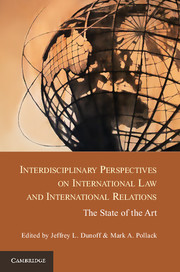 Interdisciplinary Perspectives on International Law and International Relations
Interdisciplinary Perspectives on International Law and International Relations Power, Legitimacy, and Compliance
Published online by Cambridge University Press: 05 January 2013
Cross-border collaboration among domestic regulatory agencies has become a defining feature of contemporary global governance. Substate actors meet with their peers from other jurisdictions to exchange information, coordinate enforcement, and even to harmonize the regulatory rules applied at home (Keohane and Nye 1977; Raustiala 2002; Slaughter 2004). Both the international relations (IR) and international law (IL) literatures have taken note of this form of transgovernmental cooperation, and a term in both literatures has been minted and widely adopted. “Regulatory networks” appear in myriad areas where globalization has affected a regulatory project shared across borders by agencies, industries, and interest groups. In many instances, economic interdependence forges interactions among jurisdictions with distinct domestic rules. The resulting governance frictions produce the impetus for regulatory interactions among domestic authorities delegated with responsibilities for market oversight. There are regulatory networks in antitrust (Whytock 2005; Damro 2006), aviation (Bermann 1993), data privacy (Bignami 2005; Newman 2008a), human rights (Cardenas 2003), national security (Krahmann 2003; Lipson 2005), and telecommunications (Bermann 1995) regulation, just to name a few.
In the world of financial regulation alone, which has been a particularly welcoming one for such networks, American regulators have joined the International Organization of Securities Commissions (IOSCO), the Basel Committee on Banking Supervision, the Participants Group of major export credit agencies, the Financial Action Task Force (which deals with money laundering), the International Association of Insurance Supervisors (IAIS) the semi-private International Accounting Standards Board, and the mostly private World Federation of Exchanges. In addition, the new Financial Stability Board (FSB) is meant to serve as a network of networks, coordinating the harmonization of financial regulation done by other financial regulatory networks and staffed, like them, by domestic agency officials (Singer 2004; Zaring 2005; Baker 2009; Posner 2009; Helleiner 2010; Bach and Newman 2010a; Brummer 2012).
To save this book to your Kindle, first ensure [email protected] is added to your Approved Personal Document E-mail List under your Personal Document Settings on the Manage Your Content and Devices page of your Amazon account. Then enter the ‘name’ part of your Kindle email address below. Find out more about saving to your Kindle.
Note you can select to save to either the @free.kindle.com or @kindle.com variations. ‘@free.kindle.com’ emails are free but can only be saved to your device when it is connected to wi-fi. ‘@kindle.com’ emails can be delivered even when you are not connected to wi-fi, but note that service fees apply.
Find out more about the Kindle Personal Document Service.
To save content items to your account, please confirm that you agree to abide by our usage policies. If this is the first time you use this feature, you will be asked to authorise Cambridge Core to connect with your account. Find out more about saving content to Dropbox.
To save content items to your account, please confirm that you agree to abide by our usage policies. If this is the first time you use this feature, you will be asked to authorise Cambridge Core to connect with your account. Find out more about saving content to Google Drive.